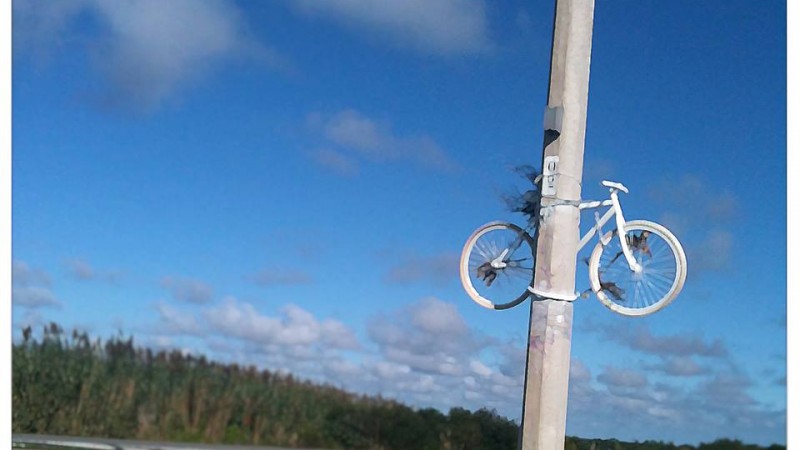
Photo published on Facebook by Bicicletas Blancas
Over the past few months, spectral white bicycles have been paying silent tribute to cyclists killed on Uruguay's roadways, while at the same time raising driver and public awareness of the importance of bicycles as a safe and healthy mode of transportation.
The initiative is not new, as some 200 cities worldwide have already taken part in the project. In Uruguay, the first ghost bike was installed on April 27, 2014, in memory of Natalia Mastroianni, a 22-year-old cyclist who was hit on la Rambla avenue near the intersection of the Carrasco bridge in Montevideo back in August of 2009.
The Bicicletas Blancas campaign was launched by Ciclovida (Life Cycle), an organization dedicated to promoting bike use and road culture, but also as a way of drawing attention to the the lack of proper cycling infrastructure.
Its aim is to encourage a cultural shift, one that takes into consideration bike transit in Uruguay, a mode of transportation that now accounts for 10 percent of the vehicles that circulate on the country's roads every day.
Ciclovida has approached government authorities in the Unidad Nacional de Seguridad Vial (Uruguay's National Road Safety Security Unit) with a view to beginning joint actions to promote both bike use and respect for the rules of the road. They also aim to raise awareness of the public service message, “We are all traffic”, which provides guidelines to drivers and cyclists on how to behave in shared traffic space.
Montevideo has implemented a number of different measures, among them new bike lanes, as a way to foster bike use.
In an article that appeared on May 26 in the Spanish daily El País on the subject of the mysterious ghost bikes chained to posts on the city streets, the coordinator of Ciclovida, Gustavo Izús, commented “University bike lanes are dangerous.”
This latest drive by Bicicletas Blancas is another step in the Ghost Bikes movement that was born in 2003 in Saint Louis, Missouri, and today is reflected in more than 200 cities around the globe.
Despite the fact that there are already two white bicycles mounted over la Rambla—the second, at la Rambla and Belastiquí, is in memory of Washington González, a 68-year-old cyclist who died on March 8, 2014—most people remain unaware of the campaign, as is evidenced by the comments in social media.
On Twitter, comments like those of Laura Lión (@LauraLionGu), who works in tourism, are common:
Me preguntaba el significado de las bicicletas. Aqui la respuesta http://t.co/WS2d3fjfHH @elpaisuy
— Laura Lión (@LauraLionGu) Mayo 26, 2014
I wondered what the bikes meant. Here is the answer http://t.co/WS2d3fjfHH @elpaisuy
For his part, Cesar A. Martínez (@CesarAMartinezR) questions cyclists and their behaviour on the roads:
También recuerda la imprudencia propia? Q significan las bicicletas blancas encadenadas en las calles? http://t.co/pfJNe64Px3 vía @elpaisuy
— CesarAMartinezR (@CesarAMartinezR) Mayo 26, 2014
Does this also commemorate their own negligence? What do the locked bikes on the streets mean?
The director of the conservative Partido Nacional Agrupación Nacionalista Compañeros, Esteban Jardín (@estebanjardin), openly supports the campaign:
Muy buena medida es similar a la que hace tiempo se utiliza en New York felicitamos a los promotores http://t.co/jibod9WNvz vía @elpaisuy
— Esteban Jardín (@estebanjardin) Mayo 26, 2014
A good initiative similar to the one used a while back in New York we congratulate the promoters.







1 comment